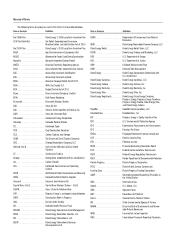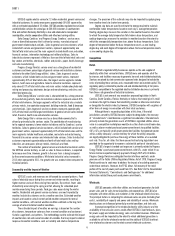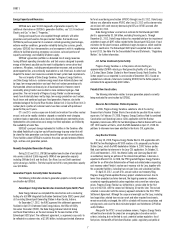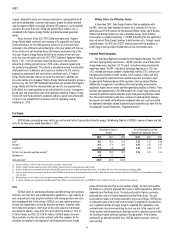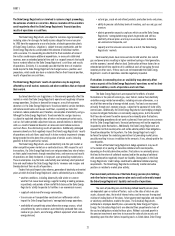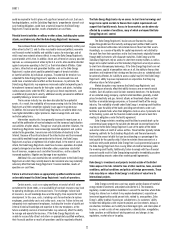Duke Energy 2012 Annual Report Download - page 32
Download and view the complete annual report
Please find page 32 of the 2012 Duke Energy annual report below. You can navigate through the pages in the report by either clicking on the pages listed below, or by using the keyword search tool below to find specific information within the annual report.
PART I
12
earns retail margin on the transmission and distribution of electricity only and not
on the cost of the underlying energy. New rates for Duke Energy Ohio went into
effect for SSO customers on January 1, 2012. The ESP also includes a provision
for a non-bypassable stability charge of $110 million per year to be collected from
January 1, 2012 through December 31, 2014.
On January 18, 2012, the PUCO denied a request for rehearing of its
decision on Duke Energy Ohio’s ESP fi led by Columbus Southern Power and Ohio
Power Company.
For more information on rate matters, see Note 4 to the Consolidated
Financial Statements, “Regulatory Matters — Rate Related Information.”
Federal
The FERC approves USFE&G’s cost-based rates for electric sales
to certain wholesale customers, as well as sales of transmission service.
Regulations of FERC and the state utility commissions govern access to
regulated electric and gas customers and other data by nonregulated entities
and services provided between regulated and nonregulated energy affi liates.
These regulations affect the activities of nonregulated affi liates with USFE&G.
Regional Transmission Organizations (RTO).
PJM Interconnection, LLC (PJM) and Midwest Independent Transmission
System Operator, Inc. (MISO) are the Independent System Operators (ISO)
and the FERC-approved RTOs for the regions in which Duke Energy Ohio and
Duke Energy Indiana operate. PJM is the transmission provider under, and the
administrator of, the PJM Open Access Transmission Tariff (PJM Tariff), operates
the PJM energy, capacity and other markets, and, through central dispatch,
controls the day-to-day operations of the bulk power system for the PJM region.
MISO is the transmission provider under, and the administrator of, the MISO
Open Access Transmission Tariff (MISO Tariff), operates the MISO energy,
capacity and other markets, and, through central dispatch, controls the
day-to-day operations of the bulk power system for the MISO region. Duke
Energy Ohio is a member of PJM and provides regional transmission service
pursuant to the PJM Tariff. Duke Energy Ohio and the other transmission owners
in PJM have turned over control of their transmission facilities to PJM, and their
transmission systems are currently under the dispatch control of PJM. Under the
PJM Tariff, transmission service is provided on a region-wide, open-access basis
using the transmission facilities of the PJM members at rates based on the costs
of transmission service. Duke Energy Indiana is a member of MISO and provides
regional transmission service pursuant to the MISO Tariff. Duke Energy Indiana
and the other transmission owners in MISO have turned over control of their
transmission facilities to MISO, and their transmission systems are currently
under the dispatch control of MISO. Under the MISO Tariff, transmission service
is provided on a region-wide, open-access basis using the transmission facilities
of the MISO members at rates based on the costs of transmission service.
Prior to January 1, 2012, Duke Energy Ohio was a member of MISO. See
Note 4 to the Consolidated Financial Statements, Regulatory Matters, for additional
information related to Duke Energy Ohio’s RTO realignment from MISO to PJM.
Other
Nuclear Matters.
The nuclear power industry faces uncertainties with respect to the cost
and long-term availability of disposal sites for spent nuclear fuel and other
radioactive waste, compliance with changing regulatory requirements, capital
outlays for modifi cations and new plant construction, the technological and
fi nancial aspects of decommissioning plants at the end of their licensed lives,
and requirements relating to nuclear insurance. Nuclear units are periodically
removed from service to accommodate normal refueling and maintenance
outages, repairs, uprates and certain other modifi cations.
USFE&G is subject to the jurisdiction of the NRC for the design,
construction and operation of its nuclear generating facilities. In 2000, the NRC
renewed the operating license for Duke Energy Carolinas’ three Oconee nuclear
units through 2033 for Units 1 and 2 and through 2034 for Unit 3. In 2003,
the NRC renewed the operating licenses for all units at Duke Energy Carolinas’
McGuire Nuclear Station (McGuire) and Catawba Nuclear Station (Catawba).
The two McGuire units are licensed through 2041 and 2043, respectively,
while the two Catawba units are licensed through 2043. The NRC has renewed
the operating licenses for all of Progress Energy Carolinas’ nuclear plants.
The renewed operating licenses for Brunswick Unit 1 and Unit 2, Harris and
Robinson expire in 2036, 2034, 2046 and 2030, respectively.
The NRC issues orders with regard to security at nuclear plants in
response to new or emerging threats. The most recent orders include additional
restrictions on nuclear plant access, increased security measures at nuclear
facilities and closer coordination with our partners in intelligence, military, law
enforcement and emergency response at the federal, state and local levels.
USFE&G is in compliance with the requirements outlined in the orders through
the use of additional security measures until permanent construction projects
are completed in 2013. As the NRC, other governmental entities and the
industry continue to consider security issues, it is possible that more extensive
security plans could be required.
Crystal River Unit 3.
In September 2009, Crystal River Unit 3 began an outage for normal
refueling and maintenance as well as an uprate project to increase its generating
capability and to replace two steam generators. During preparations to replace
the steam generators, workers discovered a delamination (or separation) within
the concrete at the periphery of the containment building, which resulted in
an extension of the outage. After analysis, it was determined that the concrete
delamination at Crystal River Unit 3 was caused by redistribution of stresses in the
containment wall that occurred when an opening was created to accommodate
the replacement of the unit’s steam generators. In March 2011, the work to return
the plant to service was suspended after monitoring equipment identifi ed a new
delamination that occurred in a different section of the outer wall after the repair
work was completed and during the late stages of retensioning the containment
building. Crystal River Unit 3 has remained out of service while Progress Energy
Florida conducted an engineering analysis and review of the new delamination and
evaluated possible repair options.
Subsequent to March 2011, monitoring equipment has detected additional
changes and further damage in the partially tensioned containment building and
additional cracking or delaminations could occur.
Progress Energy Florida developed a repair plan, which would entail
systematically removing and replacing concrete in substantial portions of
the containment structure walls, which had a preliminary cost estimate of
$900 million to $1.3 billion.
In March 2012, Duke Energy commissioned an independent review
team led by Zapata Incorporated (Zapata) to review and assess the Progress
Energy Florida Crystal River Unit 3 repair plan, including the repair scope,
risks, costs and schedule. In its fi nal report in late September, Zapata found
that the proposed repair scope appears to be technically feasible, but there
were signifi cant risks that need to be addressed regarding the approach,
construction methodology, scheduling and licensing. Zapata performed four
separate analyses of the estimated project cost and schedule to repair Crystal
River Unit 3, including; (i) an independent review of the proposed repair scope
(without existing assumptions or data), of which Zapata estimated costs of
$1.49 billion with a project duration of 35 months; (ii) a review of Progress
Energy Florida’s previous bid information, which included cost estimate data
from Progress Energy Florida, of which Zapata estimated costs of $1.55 billion
with a project duration of 31 months; (iii) an expanded scope of work scenario,
that included the Progress Energy Florida scope plus the replacement of the
containment building dome and the removal and replacement of concrete in
the lower building elevations, of which Zapata estimated costs of approximately
$2.44 billion with a project duration of 60 months, and; (iv) a “worst case”
scenario, assuming Progress Energy Florida performed the more limited scope
of work, and at the conclusion of that work, additional damage occurred in
the dome and in the lower elevations, which forced replacement of each,
of which Zapata estimated costs of $3.43 billion with a project duration



